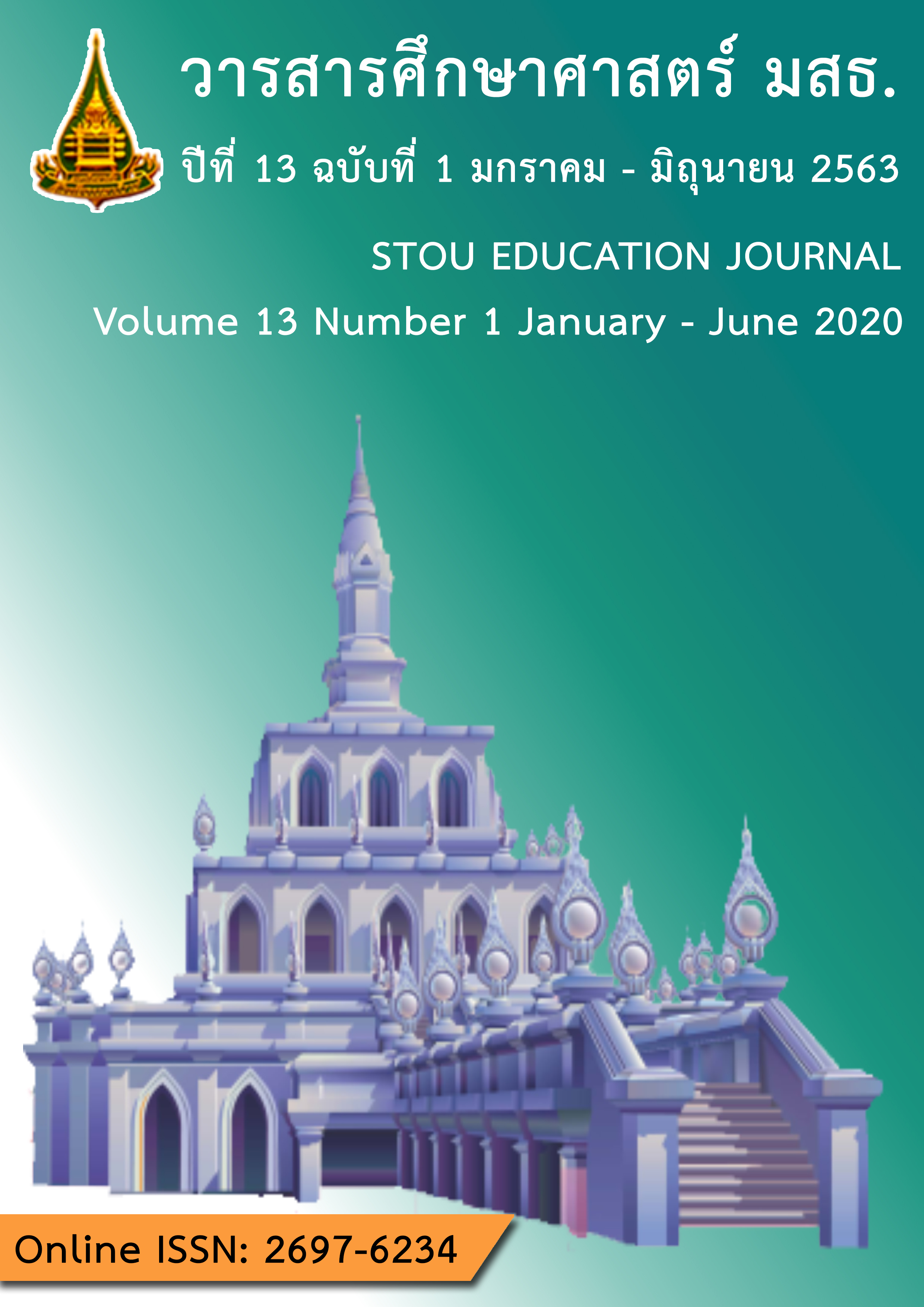นักศึกษาให้ความสำคัญกับทักษะที่จำเป็นในยุคดิจิทัลอย่างไร? การศึกษานำร่องโดยใช้การวิเคราะห์เอ็มดีเอสและเอ็มดียู
Main Article Content
บทคัดย่อ
ทักษะสำหรับศตวรรษที่ 21 มีความสำคัญในการเตรียมความพร้อมบุคลากร แต่กรอบของทักษะต่าง ๆ ที่นักวิชาการกำหนดไว้ เป็นไปอย่างกว้าง ๆ และขึ้นอยู่กับมุมมองของผู้นิยาม ด้วยความก้าวหน้าของโลกในปัจจุบันจึงมีบางทักษะที่ต้องให้ความสำคัญเพิ่มกว่าบางทักษะ การวิจัยครั้งนี้จึงมีวัตถุประสงค์เพื่อศึกษาว่านักศึกษาให้ความสำคัญกับทักษะต่าง ๆ ที่จำเป็นสำหรับบัณฑิตในยุคดิจิทัลอย่างไร มีความคิดห็นว่าทักษะใดมีความสำคัญมากกว่ากัน การวิจัยครั้งนี้เก็บรวบรวมข้อมูลความคิดเห็นของนักศึกษาจากมหาวิทยาลัยของรัฐและเอกชน จำนวน 139 คน ทั้งระดับปริญญาตรี โทและเอก เครื่องมือวิจัยคือ แบบสอบถามที่มีลักษณะเป็นการเปรียบเทียบทีละคู่และวิธีเรียงอันดับ การวิเคราะห์ครั้งนี้ใช้วิธีวิเคราะห์เอ็มดีเอส และการวิเคราะห์เอ็มดียูในการจัดกลุ่มความคิดของนักศึกษา นอกจากนี้ การวิจัยครั้งนี้ยังเปรียบเทียบผลการวิเคราะห์ด้วยวิธีการเก็บรวบรวมข้อมูลสองรูปแบบเพื่อตรวจสอบว่าวิธีการใดจะให้ผลการวิเคราะห์ที่เหมาะสมกว่า ผลการวิจัยพบว่า การวิเคราะห์ทั้งสองวิธีให้ผลการจัดกลุ่มทักษะที่จำเป็นในยุคดิจิทัลทั้งที่เหมือนและแตกต่างกัน การวิเคราะห์เอ็มดีเอสเหมาะสมกับข้อมูลแบบเรียงอันดับมากกว่า และการวิเคราะห์เอ็มดียูเหมาะกับข้อมูลที่ได้จากการเปรียบเทียบทีละคู่มากกว่า
Article Details
References
ถนอมพร เลาหจรัสแสง. (2559). การเรียนรู้ในยุคสมัยหน้า: ตอนอนาคตครูไทยครูพันธุ์ C. สืบค้นจาก http://thanompo.edu.cmu.ac.th/load/journal/50-51/Cteachers.pdf
ประกาศกระทรวงศึกษาธิการ. (2558). เกณฑ์มาตรฐานหลักสูตรระดับบัณฑิตศึกษา. สืบค้นจาก http://www.mua.go.th/users/bhes/front_home/criterion58/criterion%20_m58.PDF
ไพโรจน์ นวลนุ่ม. (2561). การประยุกต์ใช้การวิเคราะห์ตามลำดับชั้นในการวิเคราะห์ปัจจัยที่ส่งผลต่อการตัดสินใจปลูกข้าวพันธุ์พื้นเมือง กรณีศึกษาในเขตตำบลขนาบนาก อำเภอปากพนัง จังหวัดนครศรีธรรมราช. WMS Journal of Management Walailak University, 7(Special issue), 27-42.
มยุรฉัตร นพกรสุขทองดี และ อัจศรา ประเสริฐสิน. (2560). การประเมินความต้องการจำเป็นเพื่อพัฒนาการจัดการตนเองของนิสิตระดับปริญญาตรีหลักสูตรการศึกษาบัณฑิต มหาวิทยาลัย ศรีนครินทรวิโรฒ. วารสารบรรณศาสตร์ มศว, 10(2), 120-133.
สังวรณ์ งัดกระโทก. (2562). Multidimensional scaling and multidimensional unfolding เอกสารประกอบการบรรยายในรายวิชา ทฤษฎีการวัดทางจิตวิทยา 2757847 คณะครุศาสตร์ จุฬาลงกรณ์มหาวิทยาลัย. กรุงเทพฯ: เอกสารอัดสำเนา.
Alt, D. (2016). Using structural equation modeling and multidimensional scaling to assess female college students’ academic adjustment as a function of perceived parenting styles. Current Psychology, 35(4), 549-561.
Ananiadou, K., & Claro, M. (2009). 21st century skills and competences for new millennium learners in OECD countries. Retrieved from http://hdl.handle.net/123456789/2529
Bloomberg. (2015). The bloomberg recruiter report: Job skills companies want but can’t get. Retrieved from https://www.bloomberg.com/graphics/2015-job-skills-report/
Bridgstock, R. (2009). The graduate attributes we’ve overlooked: Enhancing graduate employability through career management skills. Higher Education Research & Development, 28(1), 31-44.
Costa, R., Fonseca, J., Kullberg, J., Martins, N., & Santana, F. (2015, September). Soft skills for science and technology students. Paper presented at the 2015 International Conference on Interactive Collaborative Learning (ICL). doi.10.1109/ICL.2015.7318206
DeVellis, R. F. (2017). Scale development: Theory and application (4th ed.). Thousand Oaks, California: Sage Publications.
Frot, M. (2017). 7 essential skills every graduate needs in 2017. Retrieved from https://www.topuniversities.com/student-info/careers-advice/7-essential-skills-every-graduate-needs-2017
Gilbert, K., Pedhazur Schmelkin, L., Levine, N., & Silva, R. (2011). A multidimensional scaling analysis of perceptions of academic dishonesty among fifth-grade students. Ethics & Behavior, 21(6), 471-480.
Jamieson, K. G., & Nowak, R. (2011, December). Active ranking using pairwise comparisons. Paper presented at the 24th International Conference on Neural Information Processing Systems. https://dl.acm.org/doi/10.5555/2986459.2986709
Jaworska, N., & Chupetlovska-Anastasova, A. (2009). A review of multidimensional scaling (MDS) and its utility in various psychological domains. Tutorials in Quantitative Methods for Psychology, 5(1), 1-10.
Kavanagh, M. H., & Drennan, L. (2008). What skills and attributes does an accounting graduate need? Evidence from student perceptions and employer expectations. Accounting & Finance, 48(2), 279-300.
Kruskal, J. B. (1964). Multidimensional scaling by optimizing goodness of fit to a nonmetric hypothesis. Psychometrika, 29(1), 1-27.
Laari, L., & Dube, B. M. (2017). Nursing students' perceptions of soft skills training in Ghana. Curationis, 40(1), 1-5.
Mair, P., Borg, I., & Rusch, T. (2016). Goodness-of-fit assessment in multidimensional scaling and unfolding. Multivariate behavioral research, 51(6), 772-789.
Martins, A., Cardoso, M. & Pinto, I. (2009). Multidimensional unfolding and the use of alternative input scales. Journal of Targeting, Measurement and Analysis for Marketing, 17(3), 195 - 204.
Martins, A. A. A.F., & Cardoso, M.G.M.S. (2010). Picturing agreement between clustering solutions using multidimensional unfolding: An application to greenhouse gas emissions data. Journal of the Operational Research Society, 71(2), 1-14.
Mugavin, M. E. (2008). Multidimensional scaling: A brief overview. Nursing Research, 57(1), 64-68.
Pereira, O. P., & Costa, C. A. A. T. (2017). The importance of soft skills in the university academic curriculum: The perceptions of the students in the new society of knowledge. International Journal of Business and Social Research, 7(3), 25-34.
Rodgers, J. L. (1991). Matrix and stimulus sample sizes in the weighted MDS model: Empirical metric recovery functions. Applied psychological measurement, 15(1), 71-77.
Wu, H. (2016, March). The study of influence of internet culture on ideological education of college students. Paper presented at the International Conference on Education, Sports, Arts and Management Engineering (ICESAME 2016). https://doi.org/10.2991/icesame-16.2016.139

